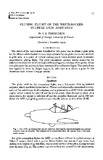| dc.description.abstract | 1. Glide-comparison measurements were made on ten species of East African soaring birds using a Schleicher ASK-14 powered sailplane. Horizontal and vertical speed differences between bird and glider were measured by a photographic method, and used to estimate the bird's horizontal and vertical speeds relative to the air. The analysis refers to the white-backed vulture, since by far the largest number of measurements was obtained on this species.
2. A regression analysis using a two-term approximation to the glide polar yielded an implausibly high estimate of induced drag, which was attributed to a lack of observations at lift coefficients above 0.72. An amended glide polar was constructed assuming elliptical lift distribution and a maximum lift coefficient of 1.6 to define the low-speed end, while the high-speed end was made to pass through the mean horizontal and sinking speeds of all the experimental points. This curve gave a minimum sinking speed of 0.76 m/s at a forward speed of 10 m/s, and a best glide ratio of 15.3:1 at 13 m/s. It did not differ significantly (in the statistical sense) from the original regression curve.
3. In comparing the estimated circling performance, based on the amended glide polar, with that of the ASK-14, it was concluded that the rates of sink of both should be comparable, but that the glider would require thermals with radii about 4.3 times as great as those needed to sustain the birds. The conclusions are consistent with experience of soaring in company with birds.
4. In an attempt to assess the adaptive significance of the low-aspect-ratio wings of birds specializing in thermal soaring, the white-backed vulture's circling performance was compared with that of an ‘albatross-shaped vulture’, an imaginary creature having the same mass as a white-backed vulture, combined with the body proportions of a wandering albatross. It appears that the real white-back would be at an advantage when trying to remain airborne in thermals with radii between 14 and 17 m, but that the albatross-shaped vulture would climb faster in all wider thermals; on account of its much better maximum glide ratio, it should also achieve higher cross-country speeds. It is concluded that the wing shape seen in vultures and storks is not an adaptation to thermal soaring as such, but is more probably a compromise dictated by take-off and landing requirements.
5. The doubts recently expressed by Tucker & Parrott (1970) about the results and conclusions of Raspet (1950a, b; 1960) are re-inforced by the present experience. | en_US |

